
2017 is quickly drawing to a close. ’Tis the season for retrospective articles! For Mignolaversity that means a four-part interview with Mike Mignola and a handful of his collaborators who were generous enough to give their time during the season when time is most a luxury. (Thank you all!) We’ll be running these pieces throughout the week.
If you missed the previous ones, here’s some handy links:
∙ Part 1: “Hellboy”
∙ Part 2: “B.P.R.D. The Devil You Know” & “Hellboy and the B.P.R.D.”

‘I think part of the reason for that shift is that I tend to think of these stories primarily as period pieces,’ explained writer Chris Roberson, ‘and so rather than treating them as long-running ongoing storylines I am more apt to look for moments in that history where particular characters might have come together in a particular spot where something interesting might have happened. And both as a writer and as a reader I usually find that there’s something satisfying about a story with a proper beginning, middle, and end, even if I know that there are other stories featuring those characters that could still be told in future. It also means that readers can come in at pretty much any point, as the beginning of any given stand-alone miniseries serves as a sort of “jumping on point.”’
‘Ideally, I would love have created this world where we can do any number of different books and it not necessarily be a whole series,’ said Mike Mignola. ‘It’s kind of like what you see right now with any number of people writing novels that kind of tap into or take place in the Lovecraft mythos world. I just think the idea of having a place where people can do stories set in any period of time would be great.’
‘This is what’s most exciting to me about working in this world,’ said Roberson, ‘finding those moments that haven’t really been fully explored before now, or taking a character like the alien from “Conqueror Worm” and exploring what brought them to that point in their lives.’

‘The Visitor book was one of my all-time favorite things,’ admitted Mignola. ‘And it was a great perspective [to explore from] because Chris could come to that as somebody who’s been observing the Hellboy Universe, so in a way him writing “The Visitor: How & Why He Stayed” is also his observation on how these events had taken place. And it was a place for him to reference my stories from a different perspective, but also plant the seeds for some of his own stuff. Some of the stuff in the book is familiar to us and some of it you go, “Wait, we haven’t seen that story.”’
‘This is another illustration of the strength of the readership these books have,’ said Roberson. ‘If I had pitched “Sad Alien Comes to Earth, Falls in Love, and Dies” it likely wouldn’t have flown off of store shelves, but the fact that it was threaded through Hellboy’s life meant that we had the freedom to tell this strange little melancholic story about mortality, memory, and loss. And it was an opportunity to work with one of my absolute favorite living cartoonists, Paul Grist, who I had been hoping to bring in to work on a Hellboy-related project since I was brought onboard.’
Grist’s work was one of the highlights of the book, especially the way he depicted Ruby’s twilight years in the fourth issue.
‘I’ve always said that Paul Grist is one of the absolute best visual storytellers working in comics today,’ said Roberson. ‘And I knew that when we got to that issue, and in particular those final moments with Ruby, that the best thing I could do would be to shut up and let Paul’s art tell the story, with as few words on the page as possible.’
Continued below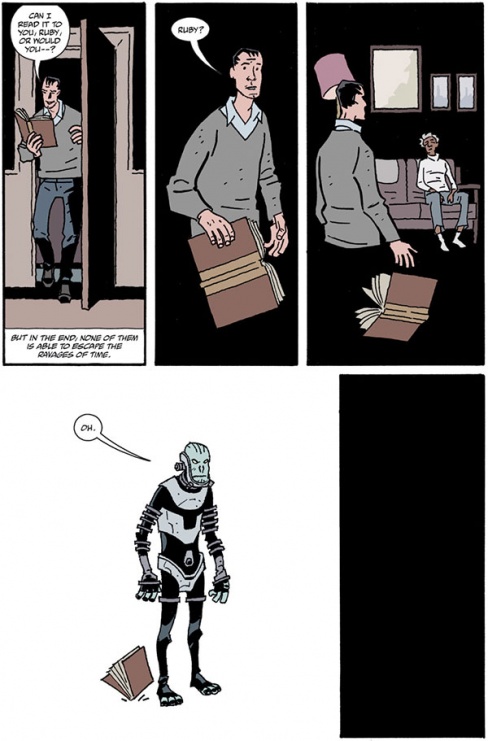
‘Ruby was part of the story, if not from the very beginning then from very early on,’ said Roberson. ‘In one of many phone conversations that Mike and I had about the book, one or the other of us brought up the idea that he would end up marrying a human woman. Mike immediately suggested the scene where the wife would walk in on him in his alien form, and the reader wouldn’t know at first whether this was a frightening reveal for her or just business as usual.
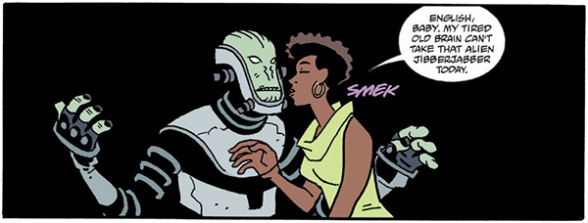
‘And as Mike was describing this warm little moment of domestic bliss for our sad little alien, I immediately said, “And of course, then he has to watch her grow old and die.” And right at that moment, it became the heart of the series.’
‘I know [the Visitor and Ruby relationship] was always in there,’ said Mignola, ‘but I didn’t know it would become the defining characteristic of the book, and I’m thrilled that it did. The beauty is it’s a book unlike anything I would’ve done and unlike anything John Arcudi would’ve done, unlike anything any of us would ever have done in the Hellboy Universe, but it just shows that there’s still room to do any kind of story set in this world.’
These series are also able to explore some of the more obscure mythology of the Hellboy Universe. The statues of Zara-Hem have appeared in “Witchfinder,” “Lobster Johnson,” “Hellboy and the B.P.R.D.,” and now “The Visitor: How & Why He Stayed,” each new story delving a little further into the mysterious Zara-Hem.

Mignola explained a little of his thought process in creating Zara-Hem and the statues.
‘In the story “The Call of Cthulhu,” [H. P. Lovecraft] introduces Cthulhu, but introduces him as a statue,’ he said, ‘and I thought it’d be nice if there was one of these things that people seem to know about, because most of this Ogdru Hem stuff, you’ve never heard of it before and suddenly it’s there and it’s like, “Oh shit, this thing just showed up! Oh, it’s so and so!” I just thought that it was great to introduce one of those things as a bunch of evil objects. Here’s something that’s been worshipped and we’ve never really had something like that. Ultimately I know Chris has talked about other places he wants to use [Zara-Hem], so that’s cool.’
‘We’ve seen hints of what I’d like to do with Zara-Hem,’ Roberson said, ‘in particular in the third issue of “The Visitor: How & Why He Stayed,” with the OHM cult and the 1950s self-help book Babylon Rising. But I’m definitely following Mike’s lead and pulling back the curtain only far enough to show a bit of what’s going on, rather than lay it all out and connect all of the dots. (Keen-eyed readers might notice that there was a reference to Babylon Rising in the second issue of “Beyond the Fences.”)’

The idea of seeding elements in one story and growing them in another is a common element in Roberson’s stories. In “Rise of the Black Flame,” which wrapped up early this year, we learned how Raimund Diestel became the Black Flame, but in the process we were introduced to Sarah Jewell, who’ll play an important part in Sir Edward Grey’s story some day, and Sandhu, who features in “Rasputin: The Voice of the Dragon” and whose sister is a part of the 1950s B.P.R.D.
‘For me that’s a perfect illustration of the strength of the readership that has built up for these titles over the years,’ said Roberon. ‘If I were to try to launch a new series set in the 1920s featuring a young South Asian man, a young African-American woman, an old white lady, and a middle-aged Scottish guy who had banded together to hunt down a death cult in the jungles of Siam, we would be lucky to make it past the second issue before the sales fell off a cliff. But because it is set in Hellboy’s world and has connections to the stories that people have already enjoyed, the readership had faith enough in what we we’re doing to support us long enough to get the story told.’
Continued belowMignola was particularly excited about Sarah Jewell. ‘We are going to see more stuff with her. I can’t remember who came up with the idea for her. I think Chris and I batted something back and forth. There’s some sort of real historical character that this character is sort of based on and, of course, Chris immediately found some actual woman adventurer character. The ground that this real person covered and the idea of doing something like that with a character set in this occult world, you just go, “Oh shit, there’s three hundred stories about her all of a sudden!”

‘Mike and I had a long chat a few years ago when he was in town for ComicsPro,’ said Roberson, ‘and he told me about an idea he had for a scene between Sir Edward Grey and a young woman in the Silver Lantern Club, exchanging stories of past brushes with the supernatural like Hooper and Quint comparing scars in Jaws. But that was all he had, as I recall, the idea of a young woman who was a lot tougher and more experienced than her youthful appearance would suggest. I went home and mulled it over, and almost immediately hit upon the idea of using globetrotting reporter Nellie Bly as a historical model, and suggested the name Sarah Jewell, which I’d been intending to use somewhere for years, but never found a home for before now.

‘We decided very quickly that when Sir Edward leaves Queen Victoria’s employ and becomes a private occult investigator, that Sarah Jewell would be his partner, and then the two of them would travel together as he hunts down the remains of the Heliopic Brotherhood. But excited as we were by the possibilities, it meant that we wouldn’t get a chance to introduce the character for several years, when we catch up to that moment in Sir Edward’s history in “Witchfinder.” When Mike and Scott first approached me with the idea of doing “Rise of the Black Flame,” I realized it was the perfect opportunity to introduce the character as an older woman, and to hint at the kinds of stories that we’ll be telling in the not too distant future.’
As for Sandhu, “Rise of the Black Flame” artist Christopher Mitten returned for “Rasputin: The Voice of the Dragon,” which allowed him to pick up the character’s story eighteen years later.
‘I’m super happy that he did the “Rise of the Black Flame” series. I love that stuff,’ said Mignola. ‘If sales will support that stuff, then we’ve got the right artist for these things and I’d love to see it go on forever.’

‘Mitten is just so fantastic at capturing the different historical and geographical settings that we toss at him,’ mused Roberson. ‘I tend to load the artists on these books down with a lot of historical image reference, and Mitten has a real knack for making the best use of what I send him (and ignoring all of the stuff that doesn’t aid the story!). At one point we had discussed following up “Rise of the Black Flame” with another miniseries set in the 1930s that would feature Sandhu and some other characters dealing with the fallout of that story, but when that project didn’t come together a lot of that ended up being folded into the backstory of “Rasputin: The Voice of the Dragon,” so it made perfect sense for Mitten to be the one to bring it to life.’
It seems “Rasputin: The Voice of the Dragon” is something that evolved out of ideas for several different projects that gradually coalesced into one.

‘As I recall, the first time I heard about it was at a dinner in Chicago a few years back with Mike and Christopher Mitten,’ said Roberson. ‘I had been thinking about exploring the British intelligence services during the war years and their encounters with the occult, and Mike outlined the broad strokes of the Bruttenholm story that he had in mind. Scott Allie was the one who suggested that Rasputin would make for a good focal point for the series, and the story developed from there.’
Mignola added, ‘I said to Chris (or Scott), “Here’s my plot for my Bruttenholm series. I don’t know if you want to use some of it, I don’t know if you want to use any of it, but I’m gonna tell you what I came up with.” And I think he ended up using about half of it. Chris is very keen on the time period and the ins and outs of the British Secret Service and all this stuff that goes on there—code breaking and all that stuff—so he was perfect. But I just came up with the broad strokes supernatural stuff. Quite a bit of what I came up with is there. Roughly half the skeleton of “Rasputin”” is this Bruttenholm project I’d come up with. Chris brought the history. And as much as I love the Heliopic Brotherhood of Ra, Chris does too, so he’s a really great guy to expand that sort of thing.’
‘I am, if anything, too keen on the time period,’ admitted Roberson, ‘and so had a tendency to get a little lost in the details, so I was lucky that I had Mike on hand to keep things on course. We ended up scrapping nearly the entirety of one issue where I had gotten a little too fixated on threading Bruttenholm’s journey through the real history of British secret intelligence, how the agents of the Special Operations Executive were trained and things like that, and the whole thing was rebuilt from scratch using Mike’s outline. As someone pointed out to me along the way (either Scott Allie or Katii O’Brien), we didn’t need to spend five pages showing Bruttenholm being trained how to use a parachute when we could simply drop in a single narrative caption in which the character says “I was trained to use a parachute”…’
World War II has always had a big impact on the Hellboy Universe, after all Hellboy arrived on Earth at the tail end of the war and many of his villains in the early “Hellboy” stories were Nazis. Yet this period of time hasn’t been explored much in the comics aside from “Sledgehammer 44” and a few flashbacks.
‘I love World War II,’ said Mignola, ‘but the characters I have that would be natural for that—Lobster Johnson I killed off before the beginning of the War, and Sledgehammer had a very limited lifespan, so we just don’t have a character to hang these stories on, unless we do it with Bruttenholm.’
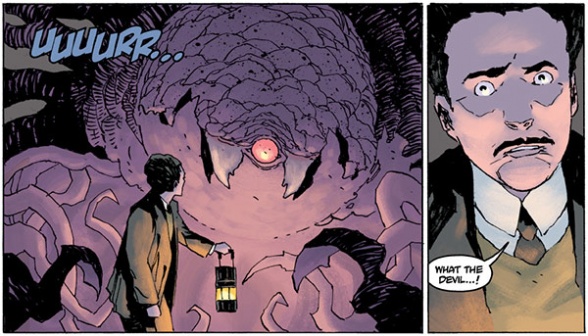
‘Bruttenholm is a great viewpoint character for stories set in that era,’ added Roberson. ‘We already know from his backstory that he had fairly wide-ranging adventures investigating the occult while he was with military intelligence, but it also means that we get a chance to explore a little more what made Trevor Bruttenholm the man who, in response to seeing a tiny demon from Hell appear out of thin air, would automatically respond “Hey, I should adopt that thing and raise it as my own son.” So as we go forward we’ll be exploring more of Bruttenholm’s foundational experiences, and what brought him to that point.’
Some readers may be aware that as a boy and a young man, Bruttenholm was influenced heavily by one of his uncles—the references to this are fleeting, and scattered throughout the Hellboy Universe books. In “Rasputin: The Voice of the Dragon,” we finally get to meet Bruttenholm’s Uncle Simon and learn more about his connection to both Sir Edward Grey and the Heliopic Brotherhood of Ra.

And Roberson agrees. ‘‘I think there is a lot of territory left to explore with Bruttenholm and Rasputin in the war years, so I would love to do more if the readership supports it.’
‘We discussed the relationship of the characters so many times and we know how all these characters relate to each other,’ said Mignola of Bruttenholm and Uncle Simon, ‘but it’s not always something that’s easy to work into the book. So part of it is trying to find stories where we can get that stuff out and touch on this history. Our approach to this stuff has been very complicated. We’ve all read a lot of history and history of occult societies, so the history of the Hellboy Universe has the complications of real world history, of how many of these groups there were, and this group was against that group, and this guy was in that group, but he was fighting with another group… and it’s not simple comics.
‘The beauty is that we’ve developed this stuff slow enough that we can give that sense of a complicated history and yet keep it from being a history book. I got to use the queen of the Heliopic Brotherhood of Ra in “Frankenstein Underground”—it was like “YES!” It was so much fun to make up the history of these characters, but there’s just no way to put it all in there. We sprinkle it in places so it feels real. When you don’t tell the whole story, but you know there’s more there, it feels real. It feels like a bigger world.’
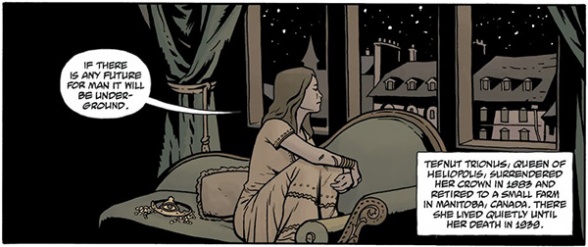
‘I think there’s a lot to be gained from leaving a lot of the backstory behind the curtain, and only revealing as much as is necessary to tell any given story,’ added Roberson. ‘It’s similar to the way that we handled the aliens in “The Visitor: How & Why He Stayed. By the time Mike and I had finished hashing it out over the phone, we had pretty much the entire backstory for those aliens worked out, including where they came from, what happened to their original home, and what they’ve been doing in the meantime. But since that wasn’t what the story that we were telling was about, only the tiniest bit of it ended up on the page. In much the same way, when introducing a character like Sarah Jewell, we might have worked out this elaborate backstory of all of her previous adventures, but it’s not necessary to document all of that for the reader, and we can instead just give enough of a glimpse into her past to get across the idea that she’s had a long life of adventuring and this is where she is at the present moment.’
Beyond the one-shot miniseries, another recent addition that’s helped shape the Hellboy Universe landscape is the “Hellboy Winter Special,” an annual anthology issue. Think of it as a winter-themed “Mike Mignola Presents” book. Short stories have always been an important part of the Hellboy Universe, but in the “Winter Special” the stories are free to explore any era and any characters without necessarily needing a connection to an existing series.
‘They’ve allowed us to be a little more flexible with the timeline than we would otherwise be,’ said Roberson, ‘getting the chance to do a “Witchfinder” story set in the 1890s or a “Hellboy and the B.P.R.D.” story in the 1960s, when otherwise it would be several years before we reach that point in the trades.’
‘It’s a great place to do things where you go, “We don’t have a comic series about the cave man, Gall Dennar.” We’ve talked about it and we can’t figure out what the fuck to call it, so…’ laughed Mignola. ‘You don’t have to worry about that if it’s just a short story in a “Winter Special” book.’

However, Mignola always has his mind on the final books. ‘Usually when we do these stories, we are thinking “Where will this story ultimately be collected?” because we don’t really do anything that we look at as a throwaway story,’ said Mignola. ‘If we do a story, it’s meant to be another piece of the puzzle and any piece of the puzzle we want to make is ultimately in print somewhere. I don’t want to have that one story out there that people have to search through bins and online to find because it came and went in some one-off comic. All that stuff is meant to be collected someplace. I think we do have a couple that we don’t quite know where they’re going to be collected or there’s a plan for where they’ll be collected, but we just haven’t got there yet.’
Continued belowRoberson relishes the challenge of the short stories. ‘I think that I’m at my most comfortable at either the short form (short stories or one-shots) or the long form (five issue arcs), and the “Winter Special” shorts are a great opportunity to cut the chaff and get right into the heart of an idea.’

Since wrapping up “B.P.R.D. Hell on Earth” in 2016, John Arcudi’s Hellboy Universe contributions this year were all “Lobster Johnson” stories—a pair of one-shots with guest artists (“Garden of Bones” with Stephen Green and “Mangekyō” with Ben Stenbeck), and “The Pirate’s Ghost,” a three-issue arc with series artist Tonci Zonjic.
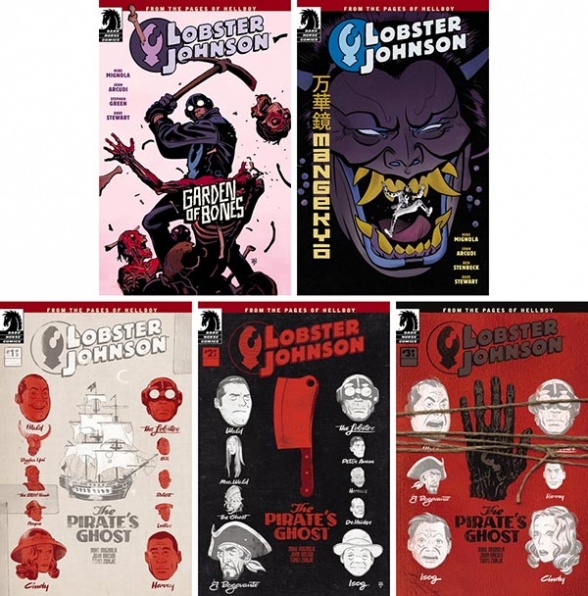
‘Every book is the opportunity to “finally get it right,” said Zonjic. “The stories have been there from the start!—so every time it’s getting closer to that Platonic ideal of the Lobster, hopefully.’
‘Trying to tell good stories, that’s the process,’ added Arcudi. ‘Not to sound vague, but that’s the truth. We’ve established a history by this point, we know where we’re going, and now we just need to focus on telling good stories.’
‘John and I have really stopped talking about future stories,’ said Mignola. ‘John doesn’t call and ask me questions. John knows the character, he knows what he wants to do, he knows where the character is, he knows where the character’s gotta go, and he doesn’t have to check with me. Maybe once or twice he’ll ask me something like, “Would it be too much if I did this?” Lobster Johnson is very much John’s character until he says, “I don’t want to do this book anymore,” which is me anticipating disaster that could happen at any time. I hope not. It’s his to do with what he wants until he doesn’t want to do it anymore or until he’s done.’
However, Mignola’s contributions are still felt in the books. Mignola recalled, ‘The pirate origin story was something I came up with a long time ago and said, “Hey John, if you ever want to use this, this is the origin I came up with for the Johnson family, for the legacy of this Johnson thing with the pirate.” I thought I could hear his eyes rolling when I told him the story. I never expected him to use any of it in any way, shape, or form.’
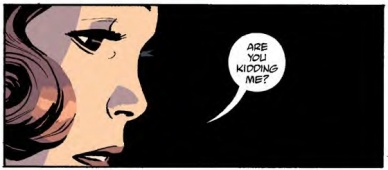
‘That whole backstory was Mike’s idea,’ said Arcudi. ‘We developed it as a backdrop that may or may not be true, in an effort to play with the pulp tradition of insane stories with even more insane histories. Mike is so much better at that pulp vibe, to be honest. But we used it to build the atmosphere of the “Lobster Johnson” series, as well as the mystique of the main character. And ultimately, it ended up being the lynchpin of that last story. Besides, wasn’t it fun seeing Tonci draw all those flashbacks with ships and mountain men, and stuff?’
‘He is pretty fucking good,’ said Mignola.
‘Tonci fucking KILLED!!!!’ agreed Arcudi.
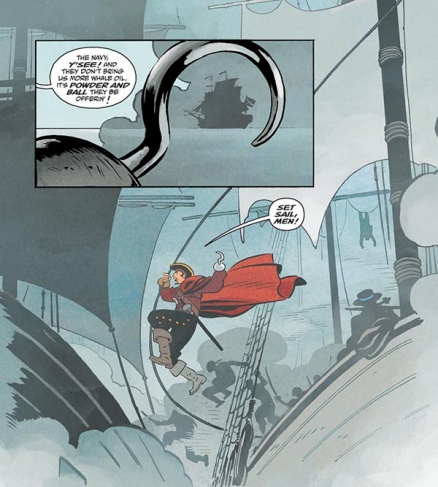
Zonjic had his own challenges on “The Pirate’s Ghost,” as he stepped into the role of colorist for the series. He had to maintain continuity with the work established by Dave Stewart, yet he found a way to inject his own sensibilities in the process.
Continued below‘I was stepping into some very big shoes there,’ admitted Zonjic. ‘It was a blast doing the whole thing, and some scenes changed completely in color. As for the challenges, just you wait for the next one…’
“The Pirate’s Ghost” also brought to a close the Isog and Wald plotline, which had been a part of the series since Arcudi and Zonjic’s first arc “The Burning Hand.”

‘Wald and Isog were written in the first script before Tonci was attached to the book (Hard to believe there was ever a time when that was the case!), but looking at Tonci’s art in “The Burning Hand,” it’s easy to believe that any reader would say “Oh, Arcudi must have seen some of Tonci’s sketches and created the characters around them.” That’s actually pretty close to the truth anyway. They were not much until Tonci brought them to life. Their long story was an outgrowth of Tonci’s ability to make them real. What writer doesn’t wish for that kind of collaborator?’
“The Pirate’s Ghost” brought about big changes to the Lobster, not so much in the character himself, but in the way we as readers see him. Where once we saw this pulpy hero, now we saw how truly monstrous he could be.

‘Whoever and whatever the Lobster is probably doesn’t matter as much as how those around him react to that,’ said Arcudi. ‘That’s always been true in the series. Harry’s probably the best example of that, and Harry’s life will likely be very different from here on out. He’s the moral center of the group, isn’t he? Or anyway, the compassionate center of the group. He’s the Lobster’s conscience, in a way. So if Harry starts to think the Lobster doesn’t actually have a conscience, where will that take him? Where does it leave him?’
‘I’m just thinking out loud here,’ added Zonjic, ‘but it would be pretty nice to have a one-shot or two-issue Harry spin-off. Heck, how about a whole book of one-shots about the “side” characters? Hmmmm…’






